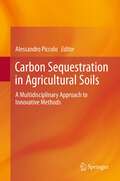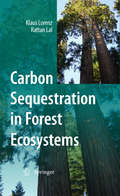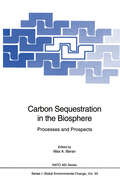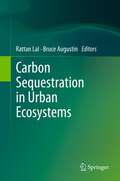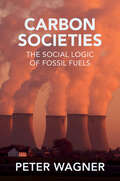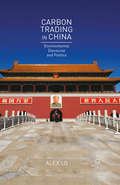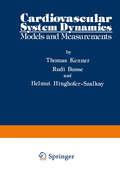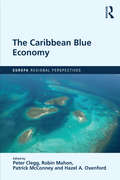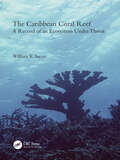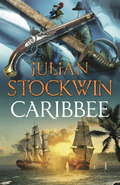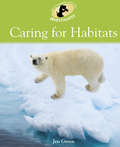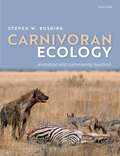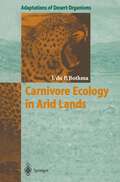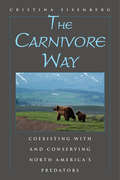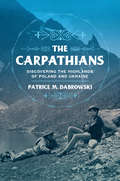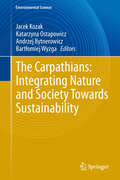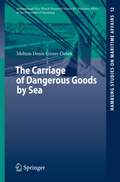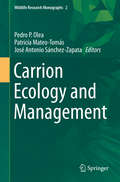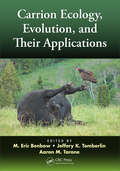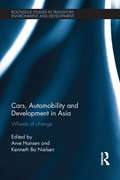- Table View
- List View
Carbon Sequestration in Agricultural Soils: A Multidisciplinary Approach to Innovative Methods
by Alessandro PiccoloThis compilation of techniques, methodologies and scientific data arises from a four-year Italian research project, which took place at university research stations in Turin, Piacenza, Naples and Potenza. Soil Organic Matter (SOM) represents an active and essential pool of the total organic carbon on the planet. Consequently, even small changes in this SOM carbon pool may have a significant impact on the concentration of atmospheric CO2. Recent new understanding of the chemical nature of SOM indicates that innovative and sustainable technologies may be applied to sequester carbon in agricultural soils. Overall results of the project have been applied to develop an innovative model for the prediction and description, both quantitatively and qualitatively, of carbon sequestration in agricultural soils. This book provides experts in different areas of soil science with a complete picture of the effects of new soil management methods and their potentials for practical application in farm management.
Carbon Sequestration in Forest Ecosystems
by Klaus Lorenz Rattan LalCarbon Sequestration in Forest Ecosystems is a comprehensive book describing the basic processes of carbon dynamics in forest ecosystems, their contribution to carbon sequestration and implications for mitigating abrupt climate change. This book provides the information on processes, factors and causes influencing carbon sequestration in forest ecosystems. Drawing upon most up-to-date references, this book summarizes the current understanding of carbon sequestration processes in forest ecosystems while identifying knowledge gaps for future research, Thus, this book is a valuable knowledge source for students, scientists, forest managers and policy makers.
Carbon Sequestration in the Biosphere: Processes and Prospects (Nato ASI Subseries I: #33)
by Max A. BeranAnthropogenic release of carbon dioxide into the atmosphere has been recognized as the primary agent in global climate change. The volume discusses the possibilities for limiting that increase by the long-term storage of carbon in soils, vegetation, wetlands and oceans. Each of these storage media is analysed in detail to elucidate those processes responsible for the uptake and release of carbon. Several chapters address the practical prospects for deliberate interventions aimed at adjusting the balance in favour of uptake over release, i.e. sequestration, while having regard to simultaneous changes in the various environments.
Carbon Sequestration in Urban Ecosystems
by Rattan Lal and Bruce AugustinUrbanization drastically alters the ecosystems structure and functions, disrupts cycling of C and other elements along with water. It alters the energy balance and influences climate at local, regional and global scales. In 2008, urban population exceeded the rural population. In 2050, 70% of the world population will live in urban centers. The number of megacities (10 million inhabitants) increased from three in 1975 to 19 in 2007, and is projected to be 27 in 2025. Rapid urbanization is altering the ecosystem C budget. Yet, urban ecosystems have a large C sink capacity in soils and biota. Judicious planning and effective management can enhance C pool in urban ecosystems, and off-set some of the anthropogenic emissions. Principal components with regards to C sequestration include home lawns and turfs, urban forests, green roofs, park and recreational/sports facilities and urban agriculture.
Carbon Societies: The Social Logic of Fossil Fuels
by Peter WagnerThe climate crisis is humanmade. Its main cause is the burning of fossil fuels. To combat climate change, we have to understand how we arrived at where we are. This book explores the reasons why human societies have embarked on the trajectory of ever-increasing use of fossil fuels.Population growth, desire for freedom from want and profit-seeking all played major roles in shaping human history, but there has been no inevitable drive towards heating up the atmosphere in the pursuit of social objectives. To sustain a growing population, more natural resources are required, but their use does not need to generate climate change. No logic of modernity links freedom with a kind of material abundance that requires the burning of fossil fuels. No logic of capital necessarily ties the search for profit to the extraction of fossil resources.Examining the critical junctures in human history when resource regimes changed, this book identifies the social problems that were meant to be solved by burning fossil fuels and the power hierarchies that shaped the decisions to use them. Wagner argues that the key choices that led to the climate emergency were made relatively recently, during the second half of the 20th century: they are close enough in time for us to undo the prevailing social logic of fossil fuels. By redefining the key problems that humankind is facing and reshaping the existing mechanisms of power, we can take the decisive action needed to reduce our dependence on fossil fuels and avert the worst consequences of climate change.
Carbon Trading in China: Environmental Discourse and Politics
by Alex LoThis book explores the political aspects of China's climate change policy, focusing on the newly established carbon markets and carbon trading schemes. Lo makes a case for understanding the policy change in terms of discourse and in relation to narratives of national power and development.
The Carey Act and Conservation in Colorado
by Gerald C. MortonThe Carey Act and Conservation in Colorado is an environmental history of the endless missteps and unforeseen consequences that characterized Colorado’s participation in the Carey Act—an 1894 federal law that granted one million acres of desert-classified public land to each western state for private irrigation development and settlement. In this inclusive narrative, author Gerald Morton reveals how this obscure law affected thirty-four of Colorado’s most arid stretches of landscape. Morton contextualizes the Carey Act’s significance in Colorado through a study of the Two Buttes and Muddy Creek projects in the state’s southeastern corner—tragic examples of the disconnect among developers seeking windfall profits in the face of financial rollercoasters, the challenge of reclaiming remote sagebrush country, and settlers seeking viable livelihoods that eventually led conservationists to reimagine the failures as public wildlife refuges. A collision of values between developers and settlers lay at the center of those wildlife habitat conservation efforts, forcing people to rethink their relationship with the land and ephemeral streams—an awareness that correlated with the advent of modern ecology. The Carey Act and Conservation in Colorado is the untold story of the manipulation of nature and the reconceived use of land for public wildlife areas on the southern plains of the American West. Offering original research on arid lands policy, federal and state agency oversight, irrigation bond financing, heartbroken settlers’ grievances, individual developers’ motives, and the rise of wildlife conservation, this compelling tale of misfortune will appeal to scholars and general readers interested in conservationist and environmental history in the American West.
The Caribbean Blue Economy (Europa Regional Perspectives)
by Peter Clegg Patrick McConney Hazel A. Oxenford Robin MahonThe Blue Economy is emerging on the global scene as a powerful and persuasive new concept for sustainable development based on economic activities associated with the ocean. Several regions globally have adopted this concept at national and regional levels, including the Caribbean. Given the complex, multisectoral and multilevel nature of the Blue Economy, it is clear that different approaches will be needed for different regions. Hence, this volume explores the opportunities, threats and risks involved in operationalising the Blue Economy in the Wider Caribbean Region, defined as northern Brazil to the USA and all mainland and island countries and territories in-between. The first part of the book looks at where the region stands in the global picture regarding adoption of the Blue Economy and what is planned. The second set of chapters examines key crosscutting issues such as ecosystem services, climate change and governance at national and regional levels that could make or break the Blue Economy initiative. The book then goes on to explore the main sectoral activities that will constitute the Blue Economies in the region: fisheries, tourism, shipping and transport, renewable energy, oil and gas, seabed mining and waste management are all considered. The book ends with a synthesis of the political and technical requirements to overcome threats and take advantage of opportunities in the Blue Economy.
The Caribbean Blue Economy (Europa Regional Perspectives)
by Peter Clegg, Robin Mahon, Patrick McConney and Hazel A. OxenfordThe Blue Economy is emerging on the global scene as a powerful and persuasive new concept for sustainable development based on economic activities associated with the ocean. Several regions globally have adopted this concept at national and regional levels, including the Caribbean. Given the complex, multisectoral and multilevel nature of the Blue Economy, it is clear that different approaches will be needed for different regions. Hence, this volume explores the opportunities, threats and risks involved in operationalising the Blue Economy in the Wider Caribbean Region, defined as northern Brazil to the USA and all mainland and island countries and territories in-between. The first part of the book looks at where the region stands in the global picture regarding adoption of the Blue Economy and what is planned. The second set of chapters examines key crosscutting issues such as ecosystem services, climate change and governance at national and regional levels that could make or break the Blue Economy initiative. The book then goes on to explore the main sectoral activities that will constitute the Blue Economies in the region: fisheries, tourism, shipping and transport, renewable energy, oil and gas, seabed mining and waste management are all considered. The book ends with a synthesis of the political and technical requirements to overcome threats and take advantage of opportunities in the Blue Economy.
The Caribbean Coral Reef: A Record of an Ecosystem Under Threat
by William K. SaccoThis book is a visual tour of Caribbean coral reefs between 1968 and 1978. They are the world’s second largest coral reef community and the most threatened. The Caribbean Coral Reef: A Record of an Ecosystem Under Threat offers a priceless historical record made by a photographer who set out to document the major reef species when those reefs were at their prime. Today, coral reefs are under threat as never before and, sadly, most of what is shown in the book's photographs is now gone forever. It is only by comparing the images in this book with what we see now that we are able to fully recognize what we have lost. With its stunning photography and precise, accurate scientific information, this book offers students of coral reefs a wealth of information about this rich, fragile ecosystem. It is also written accessibly for non-academic visitors to the Caribbean reef or anyone interested in the earth’s creatures. Many of the invertebrates will be unfamiliar to most people, and the author reveals fascinating insights into these otherworldly creatures and their lifestyles. Enjoy this field guide to the reefs that were, and savor the beauty of this vanishing environment and its organisms.
The Caribbean Coral Reef: A Record of an Ecosystem Under Threat
by William K. SaccoThis book is a visual tour of Caribbean coral reefs between 1968 and 1978. They are the world’s second largest coral reef community and the most threatened. The Caribbean Coral Reef: A Record of an Ecosystem Under Threat offers a priceless historical record made by a photographer who set out to document the major reef species when those reefs were at their prime. Today, coral reefs are under threat as never before and, sadly, most of what is shown in the book's photographs is now gone forever. It is only by comparing the images in this book with what we see now that we are able to fully recognize what we have lost. With its stunning photography and precise, accurate scientific information, this book offers students of coral reefs a wealth of information about this rich, fragile ecosystem. It is also written accessibly for non-academic visitors to the Caribbean reef or anyone interested in the earth’s creatures. Many of the invertebrates will be unfamiliar to most people, and the author reveals fascinating insights into these otherworldly creatures and their lifestyles. Enjoy this field guide to the reefs that were, and savor the beauty of this vanishing environment and its organisms.
Caribbee: Thomas Kydd 14 (Thomas Kydd #14)
by Julian Stockwin'In Stockwin's hands the sea story will continue to entrance readers across the world' - GuardianMore than a decade ago, Thomas Kydd and Nicholas Renzi were in the Caribbean as sailors before the mast in the old Trajan. Now Kydd, a storied hero of Trafalgar, holds the glory of being post-captain of the 32-gun frigate, L'Aurore. After unremitting war a Caribbean posting seems a welcome respite. But Kydd and Renzi soon find themselves facing a familiar threat as the French imperil Britain's vital sugar trade.When merchantmen begin vanishing from the sea, Kydd and Renzi must embark on a dangerous game of espionage, seamanship and breath-taking action in order to destroy a new and terrible danger to the Empire.*********************What readers are saying about CARIBBEE'A proper swashbuckling affair' - 5 stars'Totally amazing!' - 5 stars'Loved this book' - 5 stars'A real find' - 5 stars'A gripping read' - 5 stars
Caring For Habitats: Caring For Habitats (library Ebook (Environment Detective Investigates #2)
by Jen GreenWhat is a habitat?Why are habitats under threat?How can we help to take care of habitats?The Environment Detective Investigates helps you to answer these questions and many more about habitats. Find out about the different habitats on Earth, what harm pollution is doing to habitats and why they need our protection.
Carnival of the Animals: A Whole New World of Animal Poems
by null Michael MorpurgoA stunning gift collection of animal poems from master storyteller Michael Morpurgo, celebrating with heart and humour the creatures with whom we share our planet. Collaborating once more with iconic artist, Michael Foreman, Morpurgo's poems are inspired by The Carnival of the Animals – a humorous musical by the French composer Camille Saint-Saëns. Building on this classic framework, Michael has added many more animals – they speak in their own voices, full of humour and brio, to tell of their lives and the impact of humanity on their habitats. With full colour illustrations throughout, this celebrated partnership has created a gift book with a strong ecological message that will also ignite a love of poetry in young readers and will appeal to fans of The Lost Words. Above all it is a celebration of the natural world in verse, a book to treasure and to inspire. Michael Morpurgo has sold over 35 million books globally, many of them illustrated by Michael Foreman.
Carnivoran Ecology: The Evolution and Function of Communities
by Steven W. BuskirkThese charismatic mammals, which include dogs, cats, hyenas, weasels, mongooses, seals, sea lions and bears, have always held special importance to humans throughout history and continue to do so today. In recent decades, the emergence of new technologies has completely transformed our knowledge of how carnivorans interact with their environments and consequently reshaped our view of carnivoran ecology. This unique synthesis uses examples from a diverse and expanding carnivoran literature, drawing from all carnivoran families and spanning the world's oceans and continents, to produce a clearly written and richly illustrated book that reviews our current state of knowledge of carnivoran ecology. It addresses all levels of biological organization and function, from genes to enzymes, organisms, populations, and ecosystems. Special attention is given to how carnivoran species interact with their prey, each other, and humans. There is an emphasis on community interactions and their importance in carnivoran evolution, showing how evolutionary constraints (morphological, physiological, and behavioral) structure communities today. The book's approach is strongly comparative, contrasting herbivores with carnivores, predators with scavengers, and cats with dogs. Carnivorans play important roles in many high-profile conservation cases, either as species of concern or agents of endangerment, and their importance is demonstrated in both contexts. Carnivoran Ecology is an accessible advanced textbook aimed principally at senior undergraduate and graduate students taking courses in carnivore ecology, as well as a broad audience of professional academics (especially carnivore and mammalian biologists), researchers, and practitioners working in both governmental and non-governmental organizations. A significant secondary market will exist amongst the large amateur naturalist community including those wishing to explore the ecological and evolutionary links between domestic carnivorans (dogs, cats, ferrets etc.) and their wild counterparts.
Carnivore Ecology in Arid Lands (Adaptations of Desert Organisms)
by Jacobus du BothmaArid lands require that organisms inhabiting them be well-adapted to thrive or even just to survive. This book provides a review of the ecological adaptations - be they behavioural, physiological or morphological - of carnivores to arid environments. Following a general introduction into aridity and arid lands in Africa, the major carnivore families are presented. Ecological adaptations of carnivores in arid lands reveal the amplitude and resilience of the ecology of these animals. In setting up conservation measures, the nature and extent of such adaptations are important facets in determining the effective area and degree of heterogeneity required as habitat by a carnivore population so as to produce a viable unit.
The Carnivore Way: Coexisting with and Conserving North America's Predators
by Cristina EisenbergWhat would it be like to live in a world with no predators roaming our landscapes? Would their elimination, which humans have sought with ever greater urgency in recent times, bring about a pastoral, peaceful human civilization? Or in fact is their existence critical to our own, and do we need to be doing more to assure their health and the health of the landscapes they need to thrive? In The Carnivore Way, Cristina Eisenberg argues compellingly for the necessity of top predators in large, undisturbed landscapes, and how a continental-long corridor—a “carnivore way”—provides the room they need to roam and connected landscapes that allow them to disperse. Eisenberg follows the footsteps of six large carnivores—wolves, grizzly bears, lynx, jaguars, wolverines, and cougars—on a 7,500-mile wildlife corridor from Alaska to Mexico along the Rocky Mountains. Backed by robust science, she shows how their well-being is a critical factor in sustaining healthy landscapes and how it is possible for humans and large carnivores to coexist peacefully and even to thrive.University students in natural resource science programs, resource managers, conservation organizations, and anyone curious about carnivore ecology and management in a changing world will find a thoughtful guide to large carnivore conservation that dispels long-held myths about their ecology and contributions to healthy, resilient landscapes.
The Carpathians: Discovering the Highlands of Poland and Ukraine (NIU Series in Slavic, East European, and Eurasian Studies)
by Patrice M. DabrowskiIn The Carpathians, Patrice M. Dabrowski narrates how three highland ranges of the mountain system found in present-day Poland, Slovakia, and Ukraine were discovered for a broader regional public. This is a story of how the Tatras, Eastern Carpathians, and Bieszczady Mountains went from being terra incognita to becoming the popular tourist destinations they are today. It is a story of the encounter of Polish and Ukrainian lowlanders with the wild, sublime highlands and with the indigenous highlanders—Górale, Hutsuls, Boikos, and Lemkos—and how these peoples were incorporated into a national narrative as the territories were transformed into a native/national landscape.The set of microhistories in this book occur from about 1860 to 1980, a time in which nations and states concerned themselves with the "frontier at the edge." Discoverers not only became enthralled with what were perceived as their own highlands but also availed themselves of the mountains as places to work out answers to the burning questions of the day. Each discovery led to a surge in mountain tourism and interest in the mountains and their indigenous highlanders.Although these mountains, essentially a continuation of the Alps, are Central and Eastern Europe's most prominent physical feature, politically they are peripheral. The Carpathians is the first book to deal with the northern slopes in such a way, showing how these discoveries had a direct impact on the various nation-building, state-building, and modernization projects. Dabrowski's history incorporates a unique blend of environmental history, borderlands studies, and the history of tourism and leisure.
The Carpathians: Integrating Nature and Society Towards Sustainability (Environmental Science and Engineering)
by Jacek Kozak, Katarzyna Ostapowicz, Andrzej Bytnerowicz and Bartłomiej WyżgaThe book includes a broad spectrum of perspectives from different scientific disciplines (both the natural and social sciences) as well as practical knowledge. It gives a new insight into the Carpathian mountain region
The Carriage of Dangerous Goods by Sea (Hamburg Studies on Maritime Affairs #12)
by Meltem Deniz Güner-ÖzbekEver-increasing numbers of dangerous goods are carried by sea today. Worldwide concern with the risk posed by this increased frequency has led to the adoption of international technical standards to promote maritime safety and the insertion of special provisions in the carriage contracts. Moreover, growing environmental awareness and concern with the economic cost implications of maritime casualties have given rise to the regulation of liability and compensation.
Carrion Ecology and Management (Wildlife Research Monographs #2)
by Pedro P. Olea Patricia Mateo-Tomás José Antonio Sánchez-ZapataCarrion, or dead animal matter, is an inherent component of aquatic and terrestrial ecosystems worldwide, and is exploited by a wide diversity of organisms from different trophic levels, including microbes, arthropods and vertebrates. Further, carrion consumption by scavengers, i.e. scavenging, supports key ecosystem functions and services such as recycling nutrients and energy, disposing of carcasses and regulating disease spread. Yet, unlike dead plant matter, dead animal decomposition has received little attention in the fields of ecology, wildlife conservation and environmental management, and as a result the management of carrion for maintaining biodiversity and functional ecosystems has been limited. This book addresses the main ecological patterns and processes relating to the generation and consumption of carrion both in terrestrial and aquatic ecosystems. It also discusses a number of conservation concerns and associated management issues, particularly regarding the increasing role of human-mediated carrion in ecosystems. Lastly, the book outlines future research lines in carrion ecology and management, and identifies the major challenges for scavengers and scavenging processes in the Anthropocene.
Carrion Ecology, Evolution, and Their Applications
by M. Eric Benbow Jeffery K. Tomberlin Aaron M. TaroneShortlisted for the 2018 TWS Wildlife Publication Awards in the edited book categoryDecomposition and recycling of vertebrate remains have been understudied, hampered largely due to these processes being aesthetically challenging (e.g., smell and sight). Technological innovations have provided the means to explore new and historically understo
Cars, Automobility and Development in Asia: Wheels of change (Routledge Studies in Transport, Environment and Development)
by Arve Hansen and Kenneth Bo NielsenCars, Automobility and Development in Asia explores the nexus between automobility and development in a pan-Asian comparative perspective. The book seeks to integrate the policies, production forms, consumption preferences and symbolism implicated in emerging Asian automobilities. Using empirically rich and grounded analyses of both comparative and single-country case studies, the authors chart new approaches to studying automobility and development in emerging Asia.
Cars, Automobility and Development in Asia: Wheels of change (Routledge Studies in Transport, Environment and Development)
by Arve Hansen Kenneth Bo NielsenCars, Automobility and Development in Asia explores the nexus between automobility and development in a pan-Asian comparative perspective. The book seeks to integrate the policies, production forms, consumption preferences and symbolism implicated in emerging Asian automobilities. Using empirically rich and grounded analyses of both comparative and single-country case studies, the authors chart new approaches to studying automobility and development in emerging Asia.
